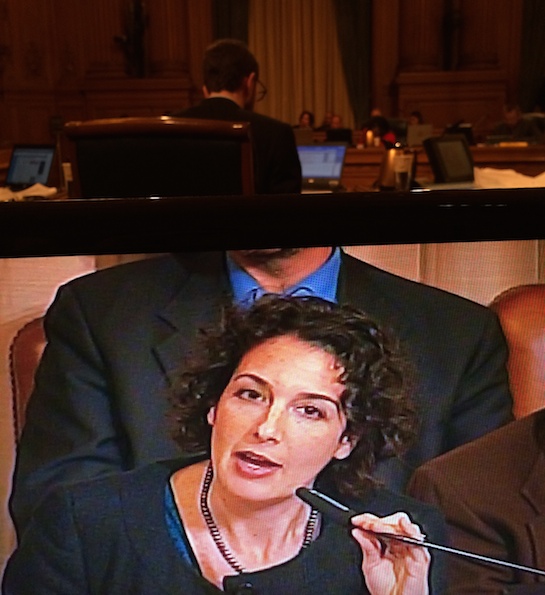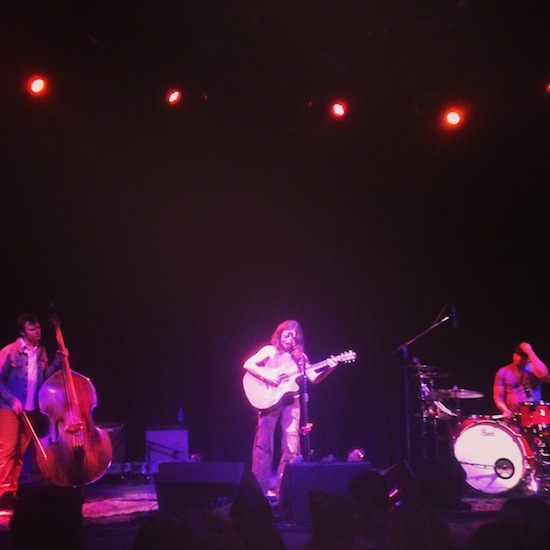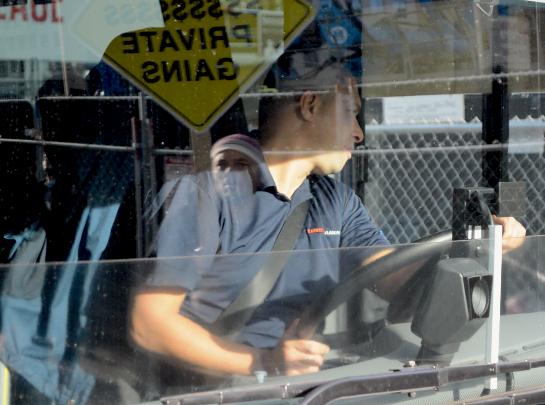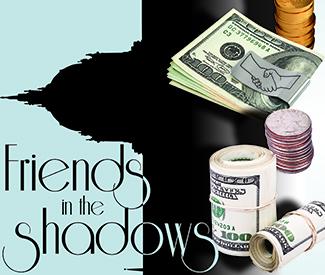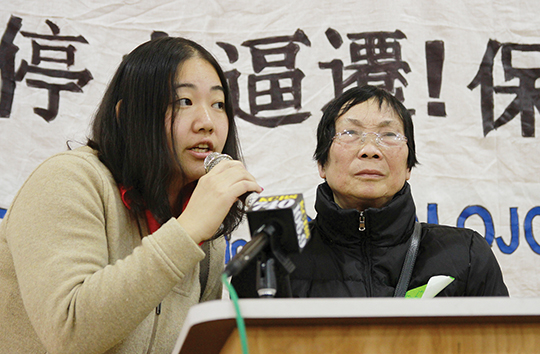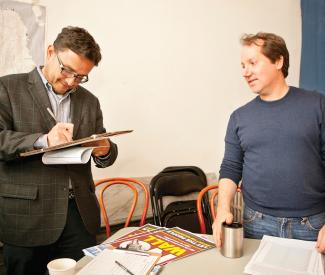Stage listings are compiled by Guardian staff. Performance times may change; call venues to confirm. Reviewers are Robert Avila, Rita Felciano, and Nicole Gluckstern. Submit items for the listings at listings@sfbg.com.
THEATER
OPENING
The Altruists Shelton Theater, 533 Sutter, SF; www.shewolftheater.com. $19-34. Opens Thu/20, 8pm. Runs Thu-Sat, 8pm. Through March 8. She Wolf Theater performs Nicky Silver’s “politically incorrect” play that exposes the real motivations behind altruistic behavior.
Hundred Days Z Space, 450 Florida, SF; www.zspace.org. $10-100. Previews Thu/20-Sat/22 and Feb 27-28, 8pm; Feb 26, 7pm. Opens March 1, 8pm. Runs Wed and Sun, 7pm; Thu-Sat, 8pm. Through April 6. Z Space presents the world premiere of a folk rock odyssey conceived and created by Abigail and Shaun Bengson.
Twelfth Night Intersection for the Arts, 925 Mission, SF; www.calshakes.org. $20. Opens Thu/20, 8pm. Runs Thu-Sun, 8pm (also Sun/23 and March 2, 2pm). Through March 2. California Shakespeare Theater kicks off its 40th anniversary season with a touring performance of Shakespeare’s classic romance, featuring an all-female cast.
The World of Paradox Garage, 715 Bryant, SF; www.paradoxmagic.com. $12-15. Opens Mon/24, 8pm. Runs Mon, 8pm (no show March 10). Through April 7. Footloose presents David Facer in his solo show, a mix of magic and theater.
Yellow New Conservatory Theatre Center, 25 Van Ness, SF; www.nctcsf.org. $25-45. Opens Fri/21, 8pm. Runs Wed-Sat, 8pm; Sun, 2pm. Through March 23. New Conservatory Theatre Center performs the Bay Area premiere of Del Shores’ Mississippi-set family drama.
BAY AREA
Lasso of Truth Marin Theatre Company, 397 Miller, Mill Valley; www.marintheatre.org. $37-58. Previews Thu/20-Sat/22, 8pm; Sun/23, 7pm. Opens Tue/25, 8pm. Runs Tue and Thu-Sat, 8pm (also March 1 and 15, 2pm; March 6, 1pm); Wed, 7:30pm; Sun, 2 and 7pm. Through March 16. Marin Theatre Company performs Carson Kreitzer’s new play about the history of Wonder Woman.
The Lion and the Fox Berkeley City Club, 2315 Durant, Berk; www.centralworks.org. $15-28. Previews Thu/20-Fri/21, 8pm. Opens Sat/22, 8pm. Runs Thu-Sat, 8pm; Sun, 5pm. Through March 30. Central Works performs a prequel to its 2009 hit, Machiavelli’s The Prince, which depicts a face-off between Niccolo Machiavelli and Cesare Borgia.
ONGOING
Children Are Forever (All Sales are Final!) Stage Werx Theatre, 446 Valencia, SF; www.brownpapertickets.com. $15. Fri-Sat, 8pm. Through March 22. W. Kamau Bell directs Julia Jackson in her solo show about adoption.
Feisty Old Jew Marsh San Francisco Main Stage, 1062 Valencia, SF; www.themarsh.org. $25-100. Sat, 8pm; Sun, 7pm (March 2, performance at 2pm; March 9, performance will be a reading of Charlie Varon’s Fish Sisters). Through March 16. Charlie Varon performs his latest solo show, a fictional comedy about “a 20th century man living in a 21st century city.”
Foodies! The Musical Shelton Theater, 533 Sutter, SF; www.foodiesthemusical.com. $32-34. Fri-Sat, 8pm. Open-ended. AWAT Productions presents Morris Bobrow’s musical comedy revue all about food.
Hir Magic Theatre, Fort Mason Center, Bldg D, Third Flr, SF; www.magictheatre.org. $20-60. Wed/19-Sat/22, 8pm (additional show Wed/19, 2:30pm); Sun/23, 2:30pm. Taylor Mac, creator of 2011’s five-hour six-director extravaganza The Lily’s Revenge, returns to the Magic Theatre with a much more straightforward, if not exactly straight, family comedy-drama in two acts. An Iraq vet named Isaac (Ben Euphrat) returns to his childhood home from the war, where his job was picking up body parts. His now touchy stomach is set off right away by the disturbing changes that have taken place while he was away. For one thing, the place is a dump. His father (a toddling, half-vacant, half-wily Mark Anderson Philips) has had a stroke that has left him an overgrown infant in thrall to his mother, Paige (a honeyed but brassy Nancy Opel), now come into her own as a liberated woman whose badge of honor is a derelict household out of all usual (patriarchal) order and discipline — and whose manner is just a little like that of an open-minded, half-savvy drag queen. Still more troubling to Isaac is his sister Maxine, now Max (an animated and winning Jax Jackson), in the midst of transitioning via regular Internet-purchased doses of testosterone. (Max insists on being addressed with gender-neutral, third-person pronouns ze, in place of she/he, and hir for him/her). Soon Isaac shores up his father’s position and mounts a counteroffensive to reclaim lost ground. An ideological turf war commences for control of the hearth and, by extension, the future of the family as an institution. Directed by Niegel Smith, the cast is competent but only intermittently effective at selling the high-octane comic premise. Jackson and Opel are the most consistent and persuasive. The play, meanwhile, has some good one-liners in addition to its intriguing premise, but gets mired in a broad and emotionally detached sitcom-like style, which can make the playwright’s more theme-oriented, expositional dialogue sound all the more jarring. Nevertheless, the play tackles a serious question: whether it is better to build on the flawed institutions one inherits and try to do better or scrap it all for something supposedly new. It has the good sense to refrain from an easy resolution of the socially and politically freighted dynamic it sets up, pointing a little vaguely to some third-way forward, outside the traditional family, in Max’s forestalled but anticipated flying of the coop. (Avila)
An Indian Summer Exit Theatre, 156 Eddy, SF; www.wehavemet.org. $20-40. Thu-Sat, 8pm. Through March 1. Multi Ethnic Theater presents local playwright Charles Johnson’s parable of race relations in the Deep South of the 1980s. On a small stage split into two alternating scenes by a movable wall in director-designer Lewis Campbell’s set, two sets of working-class residents of rural Alabama, one white and one black, have their discrete worlds unexpectedly collide. Musician Charlie Ray (a less than convincing Kevin Wisney) is fresh from the pen and living with girlfriend Pearle (AJ Davenport). Plucking at his guitar, he dreams of getting some money to afford time in a recording studio. But his brother Bobby (Paul Rodriguez) has a way of talking him into sketchy schemes, which has Pearle worried, especially after a visit from the Sheriff (Richard Wenzel). For his part, Bobby is hoping to make some money to appease his pregnant wife, Sarah (Bree Swartwood), who wants Bobby to move her and their baby to Maine. Meanwhile, Junior (a forceful Bennie Lewis, alternating nights with Stuart Hall) is a feisty wheelchair bound African American man living in a small trailer. Junior’s friend Emmitt (Fabian Herd, alternating with Vernon Medearis) tries to convince him he should put his money in a bank rather than keeping it in his trailer — especially now that Junior is selling his land for a tidy sum — but Junior doesn’t trust banks. Next, Junior gets a letter from a lawyer claiming half the profit from the land sale on behalf of a long lost, half-white relative — the offspring of an illicit romance between Junior’s father and a white woman, related to Pearle. The situation, of course, spells trouble. But while we see it coming, there’s meant to be pathos in the tangled connections among these parallel stories. Unfortunately, the artificial nature of the plot makes it hard to credit, while the desultory pace and uneven acting make the going harder still. (Avila)
Jerusalem San Francisco Playhouse, 450 Post, SF; www.sfplayhouse.org. $20-100. Tue-Thu, 7pm; Fri-Sat, 8pm (also Sat, 3pm). Through March 8. SF Playhouse presents the West Coast premiere of English playwright Jez Butterworth’s West End and Broadway hit, a three-act revel led by a larger-than-life rebel, a stout boozed-up drug-dealer, habitual fabulist, and latter-day Digger of sorts named Johnny “Rooster” Byron (Brian Dykstra). The dominion of this Falstaffian giant is the English countryside outside his squalid trailer door, not far from Stonehenge, where he seems to incarnate a rather dissipated version of an ancient English independence, like one of the great mythical beings of rural lore. Aptly enough, it’s Saint George’s Day, the feast day of England’s national saint, but it’s not all a party this time around. Authorities have issued a final 24-hour eviction notice on Rooster’s tin door; there are luxury apartments in the works; and there’s concern in town about the underage teens who flock to Rooster like so many fledglings — one, in particular, has gone missing: Phaedra (Julia Belanoff), who we see at the very outset of the play donning a fairy costume and singing the title song, based on the Blake poem and England’s unofficial national anthem. The next 24 hours will be either the breaking point or the apotheosis for all Rooster has made himself out to be. In Butterworth’s big-eyed comedy, we are meant to feel a stake in this outcome whether we actually like Rooster or not — his independence, the scope of his life and vision, suggests the outer limit of possibility in an ever more disciplined and circumscribed world. Director Bill English (who also designed the impressive bucolic-trailer-park set) and his large cast (which includes a strong Ian Scott McGregor as longtime Rooster sidekick, Ginger) dive into the comedy with gusto. But somehow the drama, the larger stakes in the storyline, falls short. A certain requisite intensity and momentum are only fitfully achieved. Dykstra, as the expansive antihero, has the biggest burden here. And while he has an appealing swagger throughout, his wayward brogue and unconvincing bellicosity undercut the culmination of the play’s (admittedly somewhat overwrought) mythopoeic proportions. (Avila)
“The Love Edition: Love Bytes” Bindlestiff Studio, 185 Sixth St, SF; facebook.com/TheLoveEdition. $10-20. Thu/20-Sat/22, 8pm. Bindlestiff performs six different tales about online dating, loneliness in the cyber age, Google stalking, and other modern-day matters of the heart.
Lovebirds Marsh San Francisco Studio, 1062 Valencia, SF; www.themarsh.org. $15-50. Thu-Fri, 8pm; Sat, 8:30pm. Through March 15. Theater artist and comedian Marga Gomez presents the world premiere of her 10th solo show, described as “a rollicking tale of incurable romantics.”
Napoli! ACT’s Geary Theater, 415 Geary, SF; www.act-sf.org. $10-120. Opens Wed/19, 8pm. Runs Wed-Sat, 8pm (also Sat, 2pm); Sun, 2pm; Tue, 7pm (March 4, show at 8pm). Through March 9. American Conservatory Theater performs a new translation of Eduardo de Filippo’s poignant Italian comedy.
The Oy of Sex Marsh San Francisco, 1062 Valencia, SF; www.themarsh.org. $20-100. Sat/22, 5pm. Comedian Alicia Dattner performs her solo show, based on her stories from her own life and love addiction.
The Paris Letter New Conservatory Theater Center, 25 Van Ness, SF; www.nctcsf.org. $25-45. Wed/19-Sat/22, 8pm; Sun/23, 2pm. New Conservatory Theatre Center performs Jon Robin Baitz’s tale of a Wall Street powerhouse desperately trying to keep his sexual identity a secret.
The Scion Marsh San Francisco, 1062 Valencia, SF; www.themarsh.org. $15-60. Thu-Fri, 8pm; Sat, 5pm. Through March 1. Brian Copeland’s fourth solo show takes on “privilege, murder, and sausage.”
Shit & Champagne Rebel, 1772 Market, SF; shitandchampagne.eventbrite.com. $25. Fri-Sat, 8pm. Extended through March 1. D’Arcy Drollinger is Champagne White, bodacious blonde innocent with a wicked left hook in this cross-dressing ’70s-style white-sploitation flick, played out live on Rebel’s intimate but action-packed barroom stage. Written by Drollinger and co-directed with Laurie Bushman (with high-flying choreography by John Paolillo, Drollinger, and Matthew Martin), this high-octane camp send-up of a favored formula comes dependably stocked with stock characters and delightfully protracted by a convoluted plot (involving, among other things, a certain street drug that’s triggered an epidemic of poopy pants) — all of it played to the hilt by an excellent cast that includes Martin as Dixie Stampede, an evil corporate dominatrix at the head of some sinister front for world domination called Mal*Wart; Alex Brown as Detective Jack Hammer, rough-hewn cop on the case and ambivalent love interest; Rotimi Agbabiaka as Sergio, gay Puerto Rican impresario and confidante; Steven Lemay as Brandy, high-end calf model and Champagne’s (much) beloved roommate; and Nancy French as Rod, Champagne’s doomed fiancé. Sprawling often literally across two buxom acts, the show maintains admirable consistency: the energy never flags and the brow stays decidedly low. (Avila)
The Speakeasy Undisclosed location (ticket buyers receive a text with directions), SF; www.thespeakeasysf.com. $60-90 (add-ons: casino chips, $5; dance lessons, $10). Thu-Sat, 7:40, 7:50, and 8pm admittance times. Through March 15. Boxcar Theatre presents Nick A. Olivero’s re-creation of a Prohibition-era saloon, resulting in an “immersive theatrical experience involving more than 35 actors, singers, and musicians.”
Ubu Roi Exit on Taylor, 277 Taylor, SF; www.cuttingball.com. $10-50. Thu, 7:30pm; Fri-Sat, 8pm (also Sat, 2pm); Sun, 5pm. Through March 9. Cutting Ball Theater performs Alfred Jarry’s avant-garde parody of Shakespeare’s Macbeth, presented in a new translation by Cutting Ball artistic director Rob Melrose.
The World’s Funniest Bubble Show Marsh San Francisco, 1062 Valencia, SF; www.themarsh.org. $8-11. Sun, 11am. Through March 9. The popular, kid-friendly show by Louis Pearl (aka “The Amazing Bubble Man”) returns to the Marsh.
BAY AREA
Can You Dig It? Back Down East 14th — the 60s and Beyond Marsh Berkeley, 2120 Allston, Berk; www.themarsh.org. $20-35. Fri, 8pm; Sat, 8:30pm. Through March 1. Don Reed’s new show offers more stories from his colorful upbringing in East Oakland in the 1960s and ’70s. More hilarious and heartfelt depictions of his exceptional parents, independent siblings, and his mostly African American but ethnically mixed working-class community — punctuated with period pop, Motown, and funk classics, to which Reed shimmies and spins with effortless grace. And of course there’s more too of the expert physical comedy and charm that made long-running hits of Reed’s last two solo shows, East 14th and The Kipling Hotel (both launched, like this newest, at the Marsh). Can You Dig It? reaches, for the most part, into the “early” early years, Reed’s grammar-school days, before the events depicted in East 14th or Kipling Hotel came to pass. But in nearly two hours of material, not all of it of equal value or impact, there’s inevitably some overlap and indeed some recycling. Note: review from an earlier run of the show. (Avila)
Escanabe in da Moonlight Live Oak Theatre, 1301 Shattuck, Berk; www.theatrefirst.com. $10-30. Thu-Sat, 8pm; Sun, 5pm. Through March 8. TheatreFIRST performs Jeff Daniels’ raucous comedy.
Geezer Marsh Berkeley, 2120 Allston, Berk; www.themarsh.org. $25-50. Thu, 8pm; Sat, 5pm. Through March 1. Geoff Hoyle moves his hit comedy about aging to the East Bay.
Gideon’s Knot Aurora Theatre, 2081 Addison, Berk; www.auroratheatre.org. $32-60. Tue, 7pm; Wed-Sat, 8pm; Sun, 2 and 7pm. Through March 9. Aurora and director Jon Tracy’s Bay Area premiere of Johnna Adams’ two-hander features strong acting, strong enough almost to make us believe in its premise. A harried mother named Corryn (a terrific Jamie J. Jones) arrives at the empty middle-school classroom overseen by a distracted teacher, Heather (a subdued yet agitated Stacy Ross). Corryn, proud but somehow desperate, admits to having not slept. Heather initially doesn’t know why she’s there — until it becomes clear she’s the mother of a recent suicide, who has come to keep her prior appointment for a parent-teacher conference. The two women await the arrival of the absent principal, but Corryn presses for answers now to the circumstances surrounding her child’s final days, which included his suspension from school and a beating received at the hands of fellow students. Heather, who seems to be hiding some separate anxiety or grief of her own (and is, though what we don’t learn until nearly the end of the play), does her best to deflect any such conversation until the principal arrives but is soon embroiled in an argument with the headstrong and canny mother in front of her, a literature professor at a major university. Their dance centers on Corryn’s son’s last assignment, a short story, one his teacher sees as nothing but “hate-filled poisonous attacks,” but his mother calls “poetry.” In addition to the clash between a teacher’s authority and a mother’s regard, there’s a class component to these differing perspectives, we presume. Yet there is a real issue here, somewhere, about art and education and authority — or would be if it did not end up buried along with the young writer we never meet. Playwright Adams advances the dramatic tension by tacking this way and that around her subject, but loses sight of the shore meanwhile, as her characters debate whether or not the short story contains a virtuous accusation against an instance of child abuse, only to drop this crux a moment later in a hard-to-credit squeamishness on Corryn’s part over the potentially homoerotic longings of her deceased son. The final note lands in an even hokier key of mutual sorrow and understanding. (Avila)
The House That Will Not Stand Berkeley Repertory Theatre, Thrust Stage, 2025 Addison, Berk; www.berkeleyrep.org. $29-59. Tue and Thu-Sat, 8pm (also Sat and March 13, 2pm); Wed, 7pm; Sun, 2 and 7pm. Through March 16. July 4, 1836: As a white New Orleans patriarch (Ray Reinhardt) passes from the scene, under somewhat mysterious circumstances, his longtime mistress, Beartrice (an imposing, memorable Lizan Mitchell), and their daughters (the charmingly varied trio of Joniece Abbott-Pratt, Flor De Liz Perez, and Tiffany Rachelle Stewart) — all free women of color — vie for dominance while trying to secure their respective futures in Berkeley Rep’s sumptuous and beautifully acted world premiere. Nationally acclaimed playwright and Oakland native Marcus Gardley (And Jesus Moonwalked the Mississippi; This World in a Woman’s Hands) brews up a historically rich and revealing, as well as witty and fiery tale here, based on the practice of plaçage (common-law marriages between white men and black Creole women), grounding it in the large personalities of his predominately female characters — who include a nosy and angling intruder (played with subtlety by Petronia Paley) — and lacing it all with a delirious dose of magical realism via the voodoo charms of Beartrice’s slave, Makeda (Harriett D. Foy, who with Keith Townsend Obadike also contributes lush, atmospheric compositions to the proceedings). Gardley delves productively into the history overall, although he sometimes indulges it too much in awkward and ultimately unnecessary expository dialogue. When he allows his characters full scope for expression of their personalities and relationships, however, the dialogue sails by with brio and punch —something the powerhouse cast, shrewdly directed by Patricia McGregor, makes the most of throughout. (Avila)
An Ideal Husband Douglas Morrison Theatre, 22311 N. Third St, Hayward; www.dmtonline.org. $10-29. Fri-Sat and Feb 27, 8pm (also Sat/22, 2pm); Sun, 2pm. Through March 2. Douglas Morrison Theatre performs Scott Munson’s adaptation of the Oscar Wilde classic, reset in 1959 Washington, DC.
The Laramie Project Masquers Playhouse, 105 Park Place, Point Richmond; www.masquers.org. $22. Fri/21-Sat/22, 8pm. Masquers Playhouse performs the theatrical collage about the real-life hate-crime murder of Matthew Shepard.
A Maze Ashby Stage, 1901 Ashby, Berk; www.justtheater.org. $20-25. Wed-Sat, 8pm; Sun, 5pm. Through March 9. Following a well-received run last summer at Live Oak Theater, Just Theater’s West Coast premiere of Pittsburgh-based playwright Rob Handel’s 2011 jigsaw drama gets a second life, courtesy of presenter Shotgun Players, in this remounting at Ashby Stage. Half the pleasure of a play like this is the unfolding of its serpentine plot, which becomes much more linear in the second half but initially seems to hover around three very disparate situations: 17-year-old Jessica (Frannie Morrison), recently escaped from eight years of captivity in the home and cellar of her kidnapper, prepares for an interview with a Barbara Walters-like TV journalist (Lauren Spencer); Oksana (Sarah Moser) and Paul (Harold Pierce), who head up their own highly successful rock band (suggestively titled the Pathetic Fallacy), are in the midst of a tough transition as Oksana checks Paul into rehab; and a fairytale King (Lasse Christiensen) responds to the Queen’s (Janis DeLucia) news that they are about to have an “heir” by beginning construction on a gigantic, seemingly endless maze emanating outward from their cozy den to the furthest reaches of the kingdom. Meanwhile, the director of the rehab clinic (Carl Holvick-Thomas) introduces Paul to another artist-resident, a fussy, eccentric author named Beeson (Clive Worsley) at work on a multi-volume graphic novel of maddening intricacy. As the three storylines begin to coalesce, the play asks us to consider questions about artistic liberty, authorship, responsibility, human connection — big themes like that. It does so in a mostly playful, only slightly eerie way, despite the grim central situation revolving around the bright and surprisingly outgoing Jessica. Employing almost the identical cast as last time, again under director Molly Aaronson-Gelb, the proceedings unfold with generally solid acting, if not always persuasive dialogue, at least where things are meant to be more or less realistic (to an extent, the fairytale segment comes across more compellingly for being strictly bound by the artificial nature of its narrative). There’s a quirky quality to the play, and the production, that amuses, even as the coy plotline bemuses. And much like an amusement park adventure, the play makes sure no one really gets lost. This is a play that is happy to tell you the various ways the central “maze” might be read metaphorically, for instance, so that everything is tidy and clear — like a fairytale, or a graphic novel — not so mysterious in the end, just tinged with a kind of comfortable melancholy. (Avila)
The Music Man Julia Morgan Theater, 2640 College, Berk; www.berkeleyplayhouse.org. $17-60. Fri and March 20, 7pm; Sat, 1 and 6pm; Sun, noon and 5pm. Through March 23. There’s trouble in River City! See it unfold amid all those trombones at Berkeley Playhouse.
Quality of Life Pear Avenue Theatre, 1220 Pear, Mtn View; www.thepear.org. $10-35. Thu/20-Sat/22, 8pm; Sun/23, 2pm. Pear Avenue Theatre performs Jane Anderson’s play about two couples coming to grips with losses in their lives.
PERFORMANCE/DANCE
“Attractive Camp” Lost Weekend Video, 1034 Valencia, SF; www.eventbrite.com. Sun/23, 8pm. $10. Stand-up comedy, sketch comedy, and short films with Kyle Mizono, Brendan Lynch, Amy Miller, George Chen, and more.
“Black Choreographers Festival: Here & Now” This week: Dance Mission Theater, 3316 24th St, SF; www.bcfhereandnow.com, www.dancemission.com. Fri/21-Sat/22, 8pm; Sun/23, 7pm. $10-20. The festival, which runs through March 8, continues its 10th anniversary with “Next Wave Choreographers Showcase.”
“Bob Rubin IS the Winter Olympics” Dark Room, 2263 Mission, SF; www.darkroomsf.com. Sat/22, 8 and 10pm. $17. The stand-up comedian performs.
“The Buddy Club Children’s Shows” Randall Museum Theater, 199 Museum Way, SF; www.thebuddyclub.com. Sun/23, 11am-noon. $8. With juggler, magician, and tongue-twister Bob Kann.
Camerata Vocale Sine Nomine St. Mark’s Lutheran Church, 1111 O’Farrell, SF; www.sfbg.org. Tue/25, 8pm. $10. SF Boys Chorus and Ragazzi Boys Chorus present the Havana, Cuba-based men’s chamber chorus, here on its first visit to the US.
Caroline Lugo and Carolé Acuña’s Ballet Flamenco Peña Pachamama, 1630 Powell, SF; www.carolinalugo.com. Sat/22, March 1, 8, 16, 22, and 30, 6:15pm. $15-19. Flamenco performance by the mother-daughter dance company, featuring live musicians.
“Chita: A Legendary Celebration” Venetian Room, Fairmont San Francisco, 950 Mason, SF; www.bayareacabaret.org. Sun/23, 3 and 7:30pm. $43-48. Two-time Tony winner Chita Rivera stars in this solo concert event highlighting memorable moments from her career.
“Comedy Returns to El Rio” El Rio, 3158 Mission, SF; www.brownpapertickets.com. Thu/20, 8pm. $7-20. Stand-up with Diane Amos, Zahra Noorbakhsh, Ian Williams, Nathan Habib, and Lisa Geduldig.
“Entertaining Mr. Sloane” Garage, 725 Bryant, SF; facebook.com/vintagewestproductions. Thu/20-Sat/22, 8pm; Sun/23, 2pm. $25. Vintage West Productions presents a 50th anniversary performance of Joe Orton’s black comedy.
“Ethel Merman Experience” Beaux, 2344 Market, SF; www.beauxsf.com. Tue/25, 10pm. Free. Ethel Merman (aka Mark Sargent) fronts this one-of-a-kind rock ‘n’ roll cover band.
Feinstein’s at the Nikko Hotel Nikko, 222 Mason, SF; www.feinsteinssf.com. This week: Paula West, Thu/20-Fri/21, 8pm; Sat/22-Sun/23, 7pm, $35-50.
“Die Fledermaus” Yerba Buena Center for the Arts, 701 Mission, SF; www.ybca.org. Fri/21-Sat/22, 8pm (also Sat/22, 2pm); Sun/23, 2pm. $15-59. Lamplighters Music Theatre (noted for its Gilbert and Sullivan productions) performs Johann Strauss’ “bubbly tale of revenge and temptation.”
“Magic at the Rex” Hotel Rex, 562 Sutter, SF; www.magicattherex.com. Sat, 8pm. Ongoing. $25. Magic and mystery with Adam Sachs and mentalist Sebastian Boswell III.
“Point Break Live!” DNA Lounge, 373 11th St, SF; www.dnalounge.com. March 7 and April 4, 7:30 and 11pm. $25-50. Dude, Point Break Live! is like dropping into a monster wave, or holding up a bank, like, just a pure adrenaline rush, man. Ahem. Sorry, but I really can’t help but channel Keanu Reeves and his Johnny Utah character when thinking about the awesomely bad 1991 movie Point Break or its equally yummily cheesy stage adaptation. And if you do an even better Keanu impression than me — the trick is in the vacant stare and stoner drawl — then you can play his starring role amid a cast of solid actors, reading from cue cards from a hilarious production assistant in order to more closely approximate Keanu’s acting ability. This play is just so much fun, even better now at DNA Lounge than it was a couple years ago at CELLspace. But definitely buy the poncho pack and wear it, because the blood, spit, and surf spray really do make this a fully immersive experience. (Steven T. Jones)
“Purple Paoli Memorial Hoopla” Brava Theatre, 2781 24th St, SF; www.brava.org. Mon/24, 7:30pm. $20-50. San Francisco clowns gather to perform and remember Bay Area circus legend Paoli Lacy.
“The Queen of Hearts” Exit Theatre, 156 Eddy, SF; www.divafest.info. Wed/19, 8pm. $25-150. Alice in Wonderland-themed performance fundraiser for the 13th annual DIVAfest.
“Solo Sundays: The Past That Haunts Us” Stage Werx Theatre, 446 Valencia, SF; www.brownpapertickets.com. Sun/23, 7pm. $12. With solo performances by Peter L. Stein, XiaoJuan Shu, and Candace Roberts.
“WritersCorps Live” Contemporary Jewish Museum, 736 Mission, SF; sfartscommission.org/WC. Thu/20, 6-7pm. Free. Award-winning author NoViolet Bulawayo reads alongside WritersCorps youth poets and teaching artists.
BAY AREA
Café Flamenco Rhythmix Cultural Works, 2513 Blanding, Alameda; www.rhythmix.org. Sun/23, 7pm. $10-20. Flamenco music and dance with Caminos Flamencos and special guests.
Cedar Lake Contemporary Ballet Zellerbach Hall, Bancroft at Telegraph, UC Berkeley, Berk; www.calperformances.org. Sat/22, 8pm; Sun/23, 3pm. $30-68. The NYC-based company performs Indigo Rose (1998), Ten Duets on a Theme of Rescue (2007), and Necessity, Again (2012).
“I Look Like an Egg, But I Identify as a Cookie” Ashby Stage, 1901 Ashby, Berk; www.shotgunplayers.org. Mon/24-Tue/25, 8pm. $20. Heather Gold brings her hit comedy back to the East Bay.
“MarshJam Improv Comedy Show” Marsh Berkeley, 2120 Allston, Berk; www.themarsh.org. Fri, 8pm. Ongoing. $10. Improv comedy with local legends and drop-in guests.
“Poetry Express” Himalayan Flavors, 1585 University, Berk; poetryexpressberkeley.blogspot.com. Mon, 7pm. Free. Ongoing. This week: fruits and vegetables theme night, plus open mic. *


